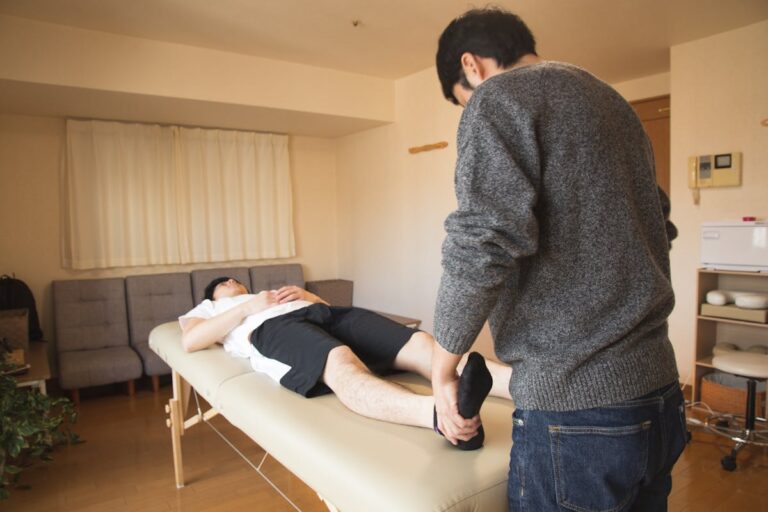Enhancing Recovery and Health Through Wellness Programs, Sports Injury Rehabilitation, and Chiropractic Adjustments
Enhancing recovery and health for athletes demands a multifaceted approach involving wellness programs, sports injury rehabilitation, and chiropractic adjustments. Each component plays an essential role in optimizing physical performance and ensuring long-term well-being. Wellness programs provide tailored strategies for nutrition and stress management. Rehabilitation focuses on evidence-based recovery techniques. Chiropractic care enhances spinal alignment and natural healing. Together, these strategies create an all-encompassing recovery framework, offering a promising path toward sustained athletic excellence.
The Role of Wellness Programs in Promoting Overall Health
Although often undervalued, wellness programs play a critical role in promoting overall health by integrating physical, nutritional, and psychological components tailored to athletes’ unique needs. These programs leverage wellness education to foster an understanding of holistic approaches, emphasizing the interconnectedness of mind and body. Evidence suggests that athletes who engage in thorough wellness strategies demonstrate enhanced performance, reduced injury risk, and improved mental health. By incorporating personalized nutrition plans, stress management techniques, and physical conditioning, wellness programs address the specific demands of athletic performance. The emphasis on holistic approaches guarantees that athletes benefit from a well-rounded regimen, optimizing their physical and mental resilience. Ultimately, these programs empower athletes to achieve peak condition sustainably, maintaining long-term health and competitive edge.
Understanding Sports Injury Rehabilitation and Its Benefits
Building on the foundation of holistic wellness strategies, sports injury rehabilitation emerges as an essential component in maintaining athletes’ health and performance. This discipline employs evidence-based rehabilitation techniques designed to expedite recovery and prevent future injuries. Utilizing a combination of physical therapy, strength training, and functional exercises, these techniques are tailored to address specific sports injuries, thereby enhancing biomechanical efficiency and reducing downtime. Research indicates that early intervention and structured rehabilitation plans greatly decrease recovery time and improve long-term outcomes. By focusing on restoring ideal function and strength, targeted rehabilitation techniques not only aid in immediate recovery but also contribute to the athlete’s overall resilience and performance longevity. Consequently, sports injury rehabilitation remains an indispensable facet of athlete-centered healthcare.
The Impact of Chiropractic Adjustments on Recovery
Chiropractic adjustments play a pivotal role in enhancing recovery from sports injuries by optimizing spinal alignment and improving neuromuscular function. These adjustments facilitate the body’s natural healing processes, leading to significant chiropractic benefits such as reduced inflammation, increased range of motion, and decreased pain levels. Evidence suggests that realigning the spine can accelerate the recovery timeline, enabling athletes to return to their activities more swiftly and safely. By improving joint mobility and reducing nerve irritability, chiropractic care supports the restoration of normal function, which is essential for athletes aiming to regain peak performance levels. Regular chiropractic sessions, tailored to the specific needs of the injured athlete, have been shown to enhance overall rehabilitation outcomes, providing an evidence-supported adjunct to traditional sports injury recovery protocols.
Combining Wellness Programs With Rehabilitation for Optimal Results
Integrating wellness programs with rehabilitation strategies can considerably enhance recovery outcomes for athletes recovering from sports injuries. Evidence suggests that wellness integration, including nutrition, mental health support, and physical conditioning, complements traditional rehabilitation approaches. This synergy fosters a holistic recovery environment, addressing both the physiological and psychological needs of athletes. By tailoring wellness programs to individual rehabilitation requirements, practitioners can optimize healing processes and expedite return-to-play timelines. Rehabilitation synergy guarantees that athletes are not merely recovering but are also improving overall well-being, reducing the risk of re-injury. Studies highlight that incorporating wellness elements into rehabilitation protocols leads to improved functional outcomes, greater adherence to recovery plans, and enhanced athlete satisfaction, ultimately fostering long-term athletic success and health resilience.
How Chiropractic Care Supports Athletic Performance and Recovery
Chiropractic care plays an essential role in enhancing athletic performance by ensuring ideal spinal alignment, which is integral for efficient biomechanical function and nervous system communication. Evidence suggests that proper alignment can reduce the likelihood of injuries by maintaining balanced muscular engagement and joint stability. Implementing chiropractic techniques as a preventive strategy can aid in minimizing downtime and promoting quicker recovery, ultimately supporting athletes in maintaining peak performance levels.
Spinal Alignment Benefits
Ideal spinal alignment is vital for enhancing athletic performance and facilitating effective recovery. Chiropractic care offers numerous spinal benefits, particularly through precise alignment techniques that optimize neuromuscular function. Athletes benefit from these adjustments as they can lead to improved biomechanics, reduced muscle tension, and enhanced range of motion. Such outcomes are significant for athletes who seek to maintain peak performance levels and minimize downtime due to injuries.
Moreover, evidence supports that proper spinal alignment can positively impact proprioception and balance, both essential for athletic prowess. By addressing misalignments, chiropractic interventions may also alleviate pain and expedite recovery processes. Consequently, athletes often include chiropractic care in their training regimens to guarantee that their spinal health contributes actively to overall performance and recovery.
Injury Prevention Techniques
Injury prevention is a critical component of athletic performance, with chiropractic care playing a pivotal role in supporting athletes’ efforts to stay injury-free. By fostering injury awareness, chiropractors help athletes recognize and mitigate risks associated with repetitive stress and biomechanical imbalances. Preventative measures, such as spinal adjustments and tailored exercise regimens, enhance joint function and muscular coordination, reducing the likelihood of strains and sprains. Evidence suggests that chiropractic interventions improve proprioception, a key factor in maintaining balance and agility during athletic activities. Additionally, regular chiropractic sessions can lead to faster recovery times, allowing athletes to maintain peak performance. By incorporating these strategies, athletes can effectively minimize injury risks and prolong their competitive careers, ensuring ideal health and performance longevity.
Integrative Approaches to Managing Chronic Pain
While traditional methods of managing chronic pain often focus on medication and rest, integrative approaches offer holistic solutions that are particularly beneficial for athletes. These approaches emphasize the mind-body connection, recognizing that mental and emotional well-being greatly impacts physical recovery. Holistic therapies, such as acupuncture, massage, and yoga, are evidence-based interventions that aim to reduce pain and enhance functionality. Research indicates that these therapies can decrease inflammation, improve circulation, and promote endorphin release, which is essential for athletes seeking ideal performance. By adopting integrative strategies, athletes can address pain’s root causes rather than merely alleviating symptoms. This thorough approach not only aids in pain management but also fosters long-term resilience, allowing athletes to maintain peak physical condition and extend their professional careers.
Personalized Wellness Plans for Long-Term Health Benefits
In the domain of sports injury rehabilitation, personalized wellness plans are pivotal for achieving long-term health benefits. By setting customized health goals and implementing tailored lifestyle modifications, athletes can optimize their recovery process and enhance overall performance. Evidence supports that individualized strategies not only expedite healing but also reduce the risk of future injuries, underscoring their critical role in sustained athletic success.
Customized Health Goals
To optimize long-term health benefits and enhance athletic performance, personalized wellness plans are increasingly recognized as essential components of sports injury rehabilitation. These plans integrate customized nutrition and personalized fitness regimens to cater to each athlete’s unique physiological needs and recovery timelines. Evidence suggests that tailored nutritional strategies can accelerate tissue repair and reduce inflammation, while individualized fitness programs target specific muscle groups, enhancing functional recovery and performance. By employing data-driven assessments, practitioners can set realistic, measurable health goals that align with an athlete’s recovery trajectory. This approach not only aids in injury recovery but also fosters sustainable health improvements, empowering athletes to maintain peak performance levels and minimize future injury risks. In this way, personalized wellness plans offer a scientifically grounded pathway to long-term athletic success.
Tailored Lifestyle Modifications
Recognizing the pivotal role of lifestyle modifications in athletic recovery and performance enhancement, tailored wellness plans serve as a cornerstone for long-term health benefits. A personalized approach, integrating holistic nutrition and stress management, is essential for optimizing athletic outcomes. Holistic nutrition focuses on nutrient-dense foods that support energy levels, muscle recovery, and immune function, aligning dietary intake with specific athletic demands. Concurrently, stress management techniques such as mindfulness practices and regulated breathing exercises are fundamental in maintaining hormonal balance and reducing injury risk. Evidence indicates that athletes who adhere to individualized wellness strategies exhibit improved resilience and sustained performance. By addressing unique physiological and psychological needs, tailored lifestyle modifications empower athletes to achieve peak condition and mitigate potential health setbacks.
Frequently Asked Questions
What Are the Costs Associated With Wellness Programs and Chiropractic Adjustments?
Cost comparisons for wellness programs and chiropractic adjustments vary widely, influenced by insurance coverage and geographical factors. Evidence suggests athletes may benefit from personalized plans, though coverage gaps might increase out-of-pocket expenses, impacting overall financial feasibility.
How Can I Find a Qualified Chiropractor or Rehabilitation Specialist?
To locate a qualified chiropractor or rehabilitation specialist, individuals should verify chiropractor qualifications through accreditation boards and check rehabilitation certifications from recognized organizations. Evidence-based practice and athlete-focused expertise are essential for effective treatment outcomes.
Are There Any Dietary Recommendations to Support Recovery and Health?
To support recovery and health, athletes should focus on precise nutrient timing, ensuring ideal macronutrient intake post-exercise. Hydration strategies are essential, emphasizing electrolyte balance to maintain performance and facilitate effective physiological recovery processes.
What Are the Potential Risks or Side Effects of Chiropractic Adjustments?
Chiropractic adjustments carry potential risks and side effects, including temporary discomfort, headaches, fatigue, and rare incidents of vertebral artery dissection. Evidence-based practices are essential for minimizing these risks, especially for athletes seeking optimized performance and recovery.
How Often Should Wellness Programs or Rehabilitation Sessions Be Attended for Best Results?
The frequency guidelines for ideal attendance at wellness programs or rehabilitation sessions depend on individual needs, typically ranging from 2-3 times weekly. Research suggests personalized schedules maximize recovery and performance, especially in athlete-focused settings.





